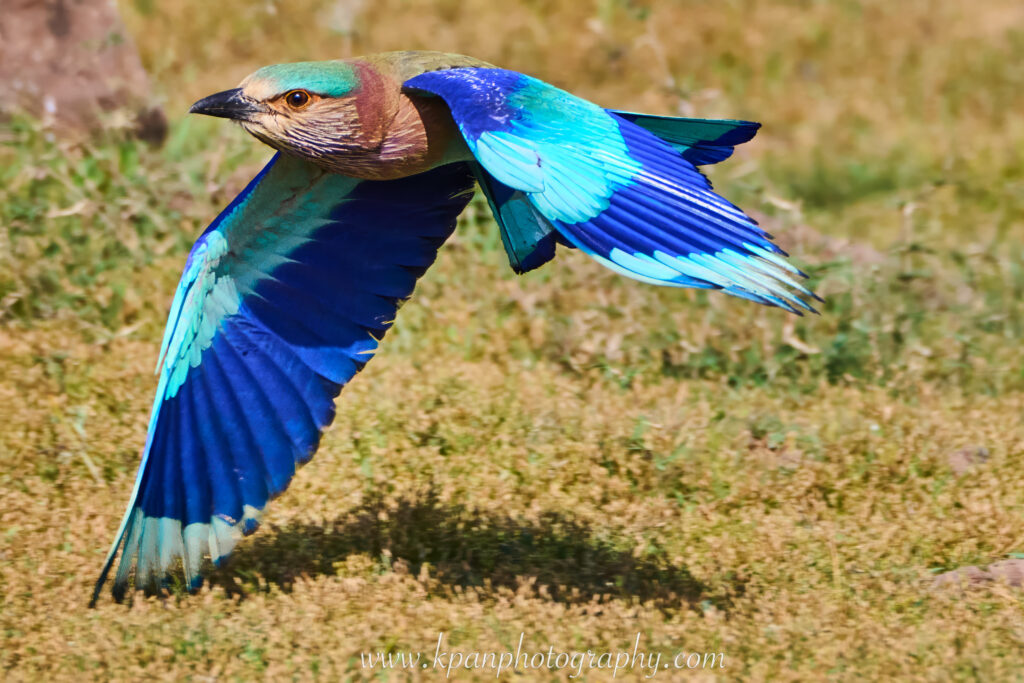Oh! He is right here! (Jess Reporter)
Let me start this event one night before it really happened. Usually I would start preparing my photo equipment one night before the next day’s safari and there was no exception that night. I brought two camera bodies and three lenses and usually I would have one camera body attached to the 180 – 600mm f5.6-6.3 + 1.4x and the other attached to the 120 – 300mm f2.8 lens. The 120 – 300mm f2.8 lens is a leftover from the DSLR era and I brought it with me because of its f2.8 fast aperture. However, for unknown reason that night I decided to attach my mid-range 24 – 120mm f4 lens to one of the bodies instead of the 120 – 300mm f2.8. I could only guess the reason was because the 120 – 300mm f2.8 is twice as heavy as the 180 – 600mm f5.6-6.3 + 1.4x and the overlap in focal range is too broad. Even though the 24-120mm f4 is a bit short but the differences between 120 to 180 is limited and the worst comes to the worst I could always crop an image. Little did I know when the decision was made the fate was sealed.
The second morning as usual we entered the tiger reserve at 6:30am sharp and started to look for tigers. After about one hour, we heard “warning calls” from monkeys and everyone was alerted and excited. There were many other 4×4 safari cars and we were running everywhere to look for the tiger and raised the dust all over. After more than half an hour we had nothing, zip, zero. I was even joking with our guide by saying “Hum, after all, monkey lies too and make a fool of us tourists!” It’s heading towards 8:30am by then and we were all on the edge because we knew that the temperature is rising and we almost don’t stand a chance after 9:00am. After 9:00am, tiger would be looking for a shady hide out, taking naps and we won’t be able to find it at all. There were more than a dozen and close to twenty 4×4 safari cars and we were all spreading out to increase the chance of finding a tiger.
Our car took a big circle back to almost where we started and the first warning call happened. Just as we approached the starting point, I heard our French guide Jess Reporter saying in an excited/surprise tone: “Oh! He is right here!” Before I could even have a clear understanding of what it means, my sight following the direction of Jess’s head to the lower right side of our car. Jess was absolutely right. A tiger just standing right next to our 4×4 within an arm reaching distance. Seriously and honestly, if Jess tilted her body toward her right side and extended her right arm she could literally touching the tiger, no exaggerating whatsoever. Supposedly fear should take over me but years of training and experience made me to do what I supposed instinctively to do. I immediately extended my left arm toward my left side because that’s where my camera and lens were. In a split second I realized I was making a mistake because that’s where the 180 – 600mm f5.6-6.3 lens was and that lens definitely was way too big at this distance. Let me put it this way, if the distance is far enough for the lens to even focus, I could only count hairs on that tiger but not a clear full frontal image. My left hand was making an awkward angle turn in the mid-air toward front left where the 24-120mm lens was and grabbed the camera and lens. As my left hand holding the camera and lens pointing towards the tiger to my right, my right index finger turned on the camera, right thumb clicked on the back focus button and right index finger pushed on the shutter release almost all happened simultaneously and the camera starting shooting at 20 frame per second. From the time I started to grab the camera till I started shooting, it’s about 1 second. There was just no time to waste.
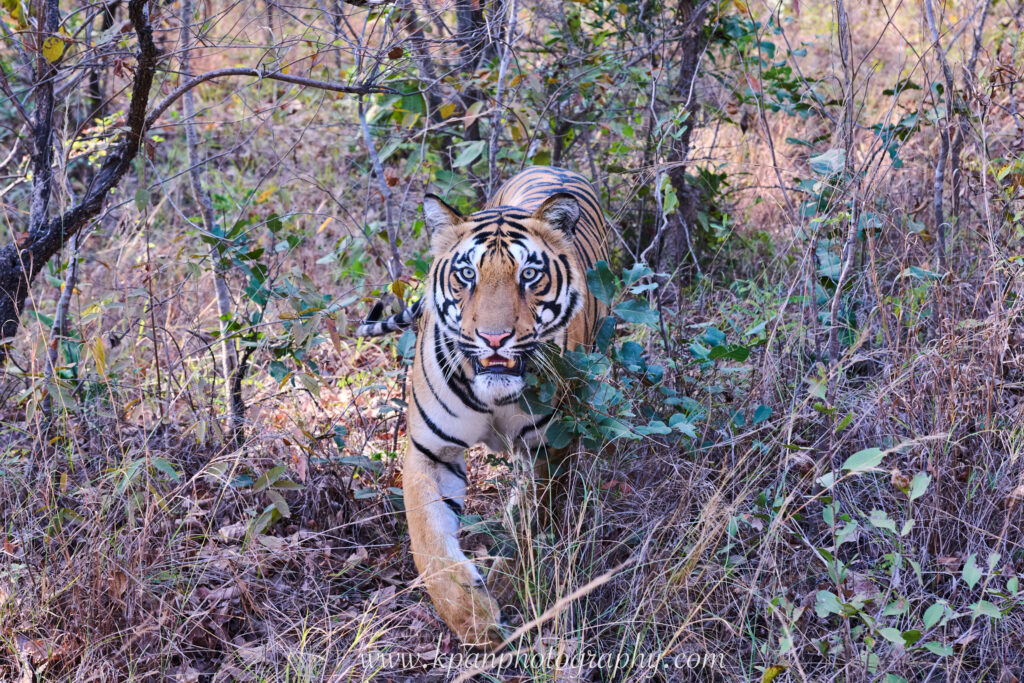
After holding onto the shutter release for less than 1 second, fear suddenly and overwhelmingly took over my mind. My trigger finger was trembling on the shutter release. I was eye-to-eye with the tiger in the viewfinder and the distance between us is less than 5 feet (1.5 meters). It was impossible not to feel the fatal threat. How would I know it’s less than 1 second? I didn’t know at the time, I felt like more than a minute at the moment but the evidence showed me it was less than 1 second. I configured my camera shooting at 20 frames per second and only when I was doing the post process I realized that there were only 15 shots which indicates it’s less than 1 second. During that less than 1 second time I was thinking to look for a shelter to hide before it’s too late. On the other hand, I was clearly understanding that there was no place for me to hide with that kind of distance between the tiger and me. When Jess our guide saw the tiger, it was right at her right side. When the car stopped, the tiger was right at my position. If the tiger jumps at the moment, I am done for, period. I told myself may as well enjoy the moment and keep shooting. I kept my trembling finger on the shutter release till our driver back our safari car out of the tiger’s path and then the tiger disappeared into the forest. Not till this moment, the other safari cars rushed over.
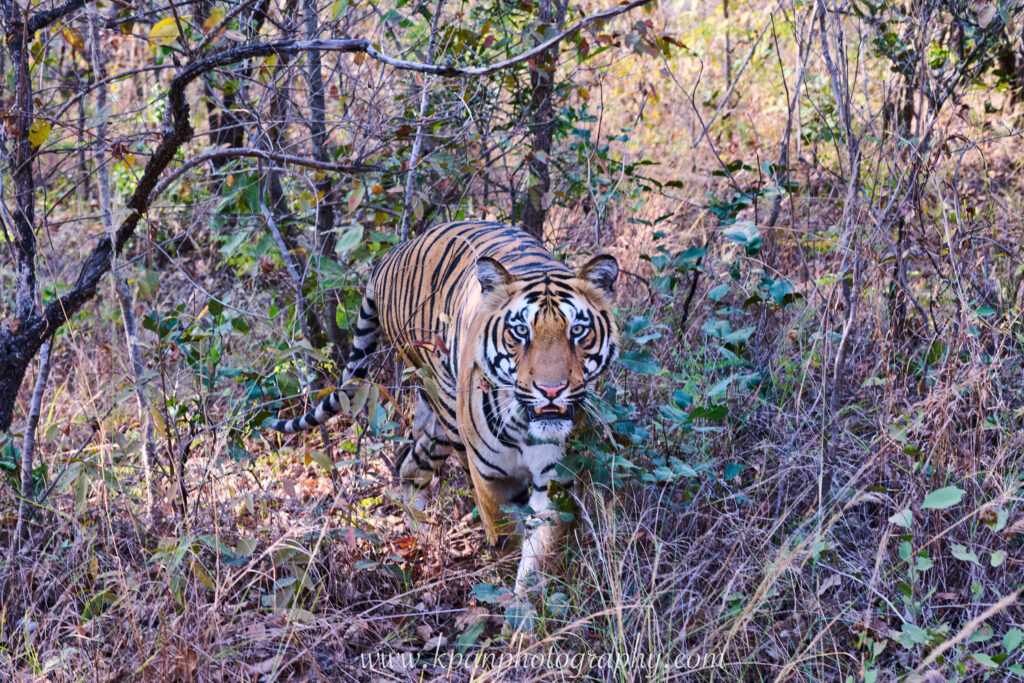
Why did I take only less than a second’s time to shoot the tiger? Let me try to restore what happened at the moment. It was a total chaos and severe turmoil at the moment. During that 1 second time frame while I was grabbing my camera, our local guide was the first one who reacted and took action because he knew the danger. He instantly told the driver to back off the car and in the mean time notified our French guide, Jess Reporter, that we must back off. In a split second Jess told me to sit tight and the car is moving. Just as I sit back to my seat before I even had a chance to hold on to the safety rail, the car jerked violently and started to back off. You may see all the dust flying all over in the following picture which was caused by the car backing off violently and fast. I almost fell onto the floor of the car. However, I truly appreciate what the local guide did with such a call. Honestly, I don’t have any hard evidence but I believe this call saved my life. We were way too close to the tiger and tigers have very strong territorial awareness. We were right at his front door steps and on his face. I bet the tiger was also in some sort of shock and absentminded for a second. If we stayed one more second when the tiger woke up and recovered with its instinct, he might as well jump and kill. If that happened, I would be the one he jumped at. Game over for me! So I believe the local guide’s call truly saved my life.
It’s breakfast time before long. Since we left the hotel at 6:00am, we usually get our breakfast at around 9:30am in the park. Because of chasing the tiger this morning, we didn’t have our breakfast till 10:00. It was only at this moment I had an opportunity to talk to our guide Jess and ask her how did she do and fell? She said that her hands were still trembling even now because even she had a few experiences in tracking tigers but never this close, never. I then ask her if she got any shots of the tiger and she said no. She continued with saying that there were too much emotions at the moment: surprising, exciting, fear, happy…….and so on so forth. Plus, she knew the lens on her camera was way too long for the job and she told herself why not just put down everything and immerse herself in the moment and enjoy it. This kind of opportunity doesn’t come everyday as she said. So, she was sitting there observing every movement of the tiger and totally enjoying the moment for the time being. What a smart and excellent guide! Our local guide was sitting at the left front seat and he was the first one supposed to see the tiger but he missed. The tiger was actually passed our driver to the right side of the car and he missed the tiger too. If it was not our guide Jess, we most likely would still be circling the dirt roads at the time. Jess made this all possible and happen.
While we were enjoying our hard earned breakfast, suddenly more than a dozen or close to 20 local guides came and circled around us. As I was wondering what’s happening, our local guide told me that they want to see the picture of the tiger we got this morning. He then further explained that because no one truly had a clear view of the tiger there was an argument happening between two groups of local guides: one group thinks the tiger we saw this morning was tiger A yet another group thinks it’s tiger B and they couldn’t settle the argument. Then they wanted evidence and no thing better than a picture of the tiger for evidence. They asked around only realized no one got a full frontal face picture of the tiger this morning other than people in our car. They all came to us and I was the only one who had a full frontal face and whole body picture of the tiger thanks to the 24-120mm mid-range lens. Once they saw the full frontal face and whole body picture, they settle the argument once for all and everything back to usual. Let me explain one thing here, all the local guides are very proud of the tigers within their jurisdiction and under their care. There were more than 40 tigers in Tadoba National Park and they would memorize every single one of them including their name, gender, age and even a tiger’s parents, father and mother’s name, and how many offsprings if it’s a tigress. So, with such distinguished knowledge, an argument like this is hard to come by. Finally this tiger was identified as “Kalwa”, male, two and half years old. He is also the most famous male tiger, king of the kings, in Tadoba tiger reserve “Chota Makta” and female tiger “Bulbi’s” offspring.
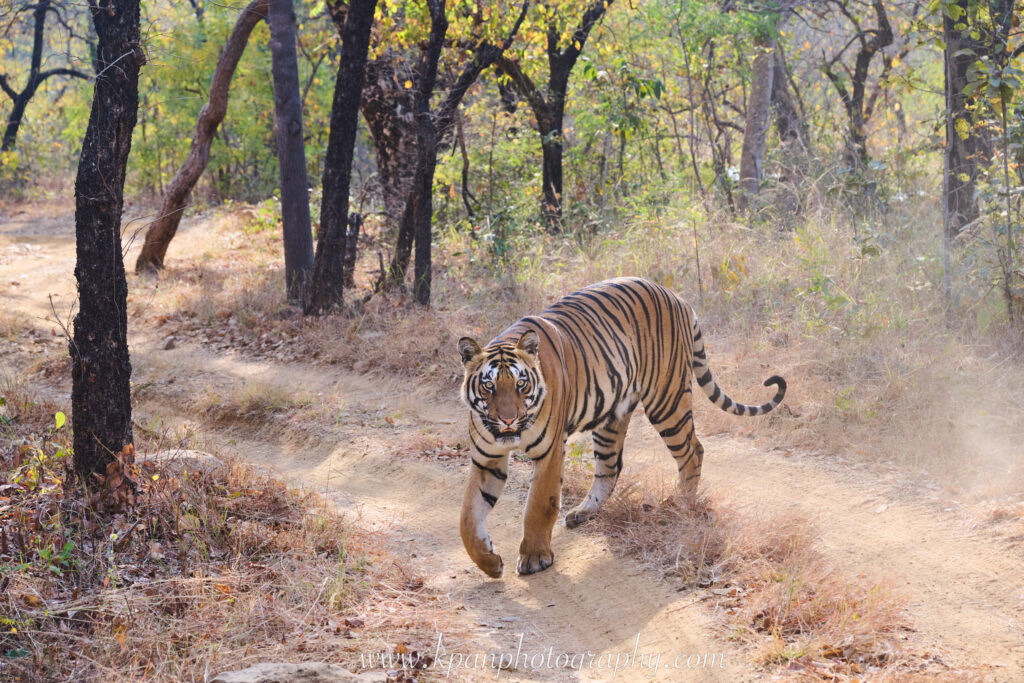
First of all, I must thank our French guide Jess Report. Without her discovery of the tiger right there, there is no way I could catch such beautiful images of it. She has an outstanding keen sense of animals. It’s not just this time that she was the first and only one who saw the tiger, there were many other occasions that she was the first to spot a bird, a monkey and many other animals. We need a guide like her who has this kind of keen sense of wildlife, this, after all, is a safari adventure trip. Second, I appreciate my Nikon equipment. Like I mentioned before from the time I grabbed the camera till start shooting at 20 frames per second the time gap was about 1 second. I appreciate such outstanding tools that functioning under such pressure so I could get clear and beautiful images. Modern photo equipment was really becoming an extension of a photographer’s mind and arm. I then must thank myself for the unknown reason one night before to put the 24-120mm f4 lens on instead of the usual 120 – 300mm f2.8 lens. If I attached the big lens not only it’s too big for the job, it’s too heavy for me to hold onto it for too long. Most of the other photographers there didn’t get a full frontal face picture mainly because either they missed the opportunity or they all had their big long lens attached to their cameras and it’s a wrong tool for the job. Wildlife photography definitely has fluid and dynamic situations and need a different set of skills, mentality and equipment. This harsh yet welcoming experience would let me remember and savory it for a very, very long time.
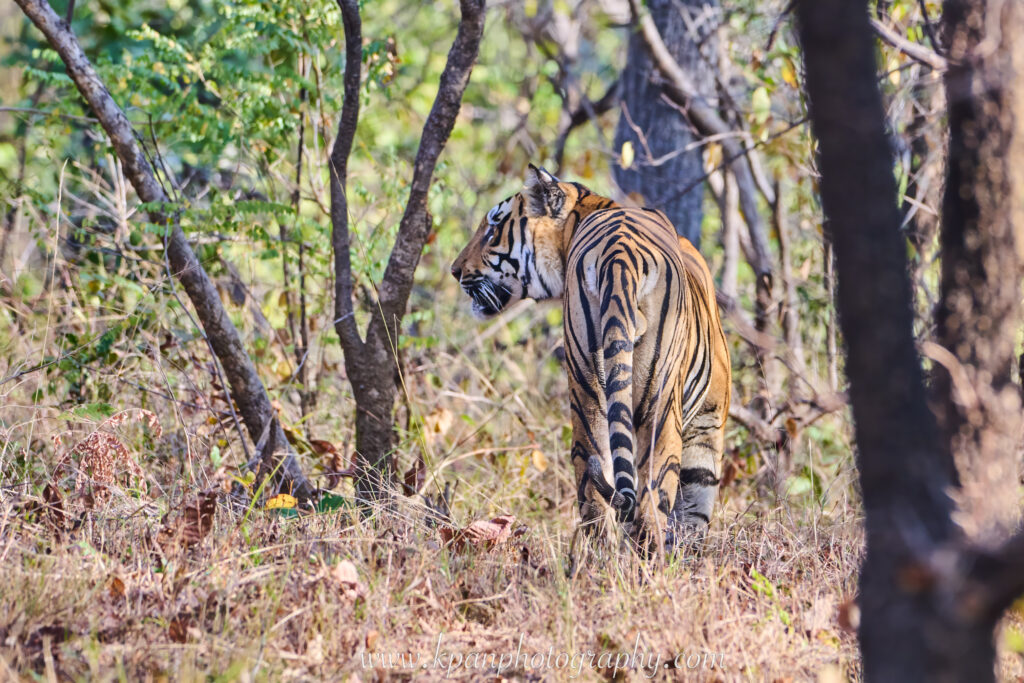
King of the kings
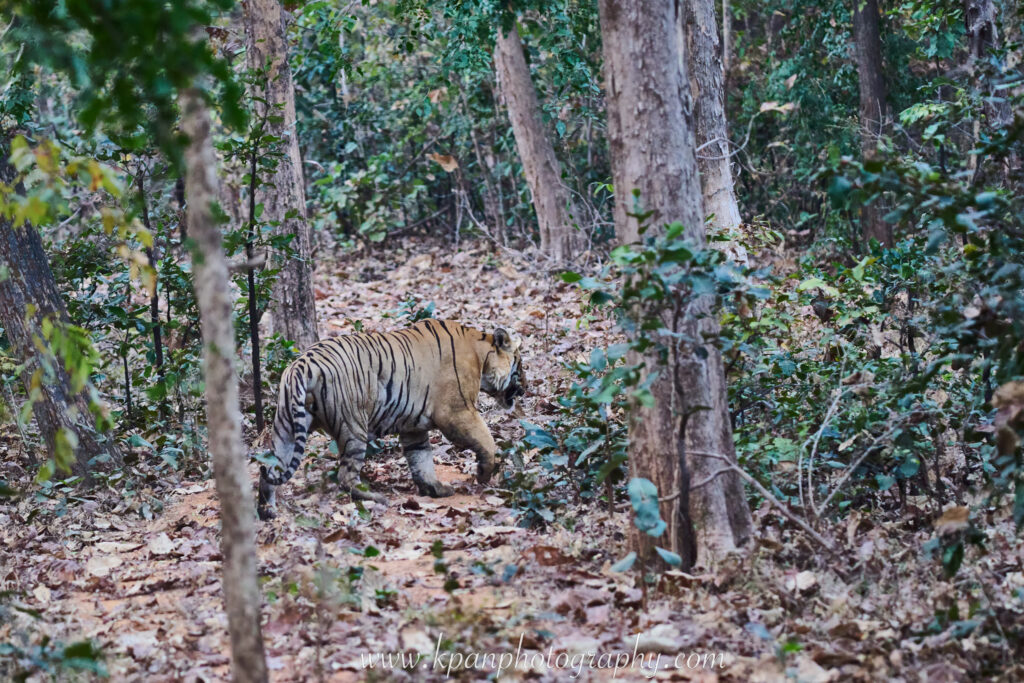
These few images are a male tiger named “Chota Matka”. Why am I talking about him here? He is the most famous tiger at Tadoba national park/tiger reserve. He is famous because he is the king of the king in tiger kingdom at Tadoba. There are more than 40 tigers at Tadoba and most of them were his offsprings with other tigresses. Moreover, there were other male tigers tried to challenge this king and the king smashed the challengers and killed them right there and then. When we were tracking or hunting other tigers, we could sense that these tigers were bothered by our existences and intense behaviors. More often than not, more than a dozen and close to 20 safari cars carrying more than 100 people would chasing a tiger. These cars would change locations, angles and driving ruthlessly trying to fight a position to see the tiger. We could see the tiger was bothered or at east annoyed by us and looking at our directions from time to time trying to find out what’s our intentions or motives. But Chota Matka is different, totally, entirely different. From the time we found him strolling in the dense forest, close to 20 safari cars were surrounding him, fighting positions and trying to getting closer to observe him. The chaos, nosies and dust disturbed by us were tremendous. The king? The king never turned around and looked at us, not even a glance. The king entirely and totally ignored us, more than 100 people. This is why I have only his profile shots and not a full frontal face one. Like I said, he didn’t even care to take a glance at us.
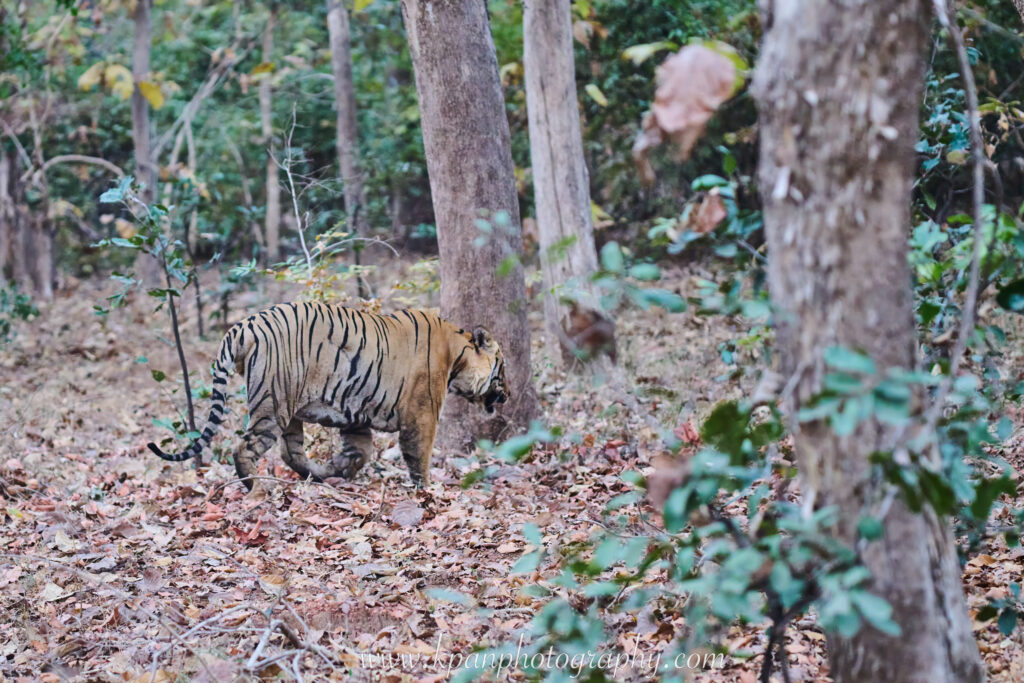
A king is a king and he is careless, domineering, unscrupulous and arrogant.
Note: Chota Matka is so famous and he has his web page on his own and even his own clips on YouTube. If you are interested, feel free to search for “Tadoba, Chota Matka” online.
Tiger hunting and tracking
I spent 11 days and totally 19 safari trips at two tiger reserves and learned how to track and hunt for tigers in India.
Basically there are two different safari periods in a day: one in the morning and the other in the afternoon. Starting and ending time are different depending on the different reserves. I have heard that there is a whole day safari available as long as you are willing to pay extra but I had never participated one so I can’t comment on that. Nevertheless, I don’t think it’s worth it because between 10:30am and 3:30pm it’s too hot for tiger to have almost any movement. Most of the time tigers would find a hide out under shades and take a long nap during that period of time. Even if anyone could find a tiger, most likely it is taking a nap and may be able to observe it yawning or stretching during naps. On the contrary, people could only be sitting in a safari car, exposing to the sunlight and getting slowly roasted. So, personally I really don’t see the point to do a whole day safari.
It starts very early in the morning usually we must get up around 5:30am to get ready and a transportation would come to pick us up at 6:00am at the hotel. Then we would be transported to the gate of a reserve and waited to be released into it. At the gate, the local guide and driver would take care of the administrative process such as pay the fee, check identification and so on. Depending on the reserve the entering time is either 6:00am or 6:30am and they follow the time very strictly not even one minute early. We as tourists, of course, are eager to enter the gate so as the driver and the local guide because they want to start their work and tracking and hunting a tiger is a very exciting process. However, rule is rule and we must wait down to the exact minute to enter the gate, otherwise, the local guide and driver would be in trouble.
Once all the safari cars enter the gate then everyone is on its own. Usually a tiger reserve is a huge piece of land and there are multiple paths and cars would spread out to hunt for tiger on their own. Of course, it’s inevitably there are multiple cars traveling on a same path and the dust would be flying and spreading all over. At this moment, the local guide would pay careful attention on the ground to see if there is any tiger foot print or trace or any evidence left by tigers. In addition to tiger’s foot prints we even saw a tiger’s droppings once. In the very beginning, everyone was very excited and encouraged because shouldn’t tiger just be around since we saw their footprints and even droppings? The reality is not really. I participated 19 safari and not even once we found a tiger by tracing its foot prints. Then how do we even find tigers, you may ask? Warning calls! I would say between 50 to 60% of the time we found tigers by following warning calls. Then what is a warning call? Warning calls were initiated by monkeys. Monkeys have their advantage point, they stay on top of trees and would sent out warning calls as soon as they see a tiger around. No exceptions. Moreover, as long as you heard the warning call once, you won’t forget it. It’s a very distinctive sound. At first when my guide told me that noise is a “warning call”, I thought there was an artificial sensor and would make noise with speakers once the sensor detected a tiger. Only later on when I was watching a documentary film I learned the distinctive sound was made by monkeys. Once we heard the warning calls, all the local guides and drivers would be alerted and focused on where the calls are from. Everyone would pay extreme attention to that direction and expect a tiger would walk out from the dense forest. There were a couple of times we heard warning calls a few times but there was no tiger whatsoever after waiting a prolong period of time. I was even joking with our local guide saying “Do monkeys also lie? Just to make a fool out of us tourists?” But seriously, warning calls are effective. Like I said we found a tiger by following monkey’s warning calls with 50 to 60% successful rate. There were about 20% chance we were just lucky and ran into one. Then what happened to the rest 20 – 30 %? There were simply no sight of tigers. Yes, it’s no guarantee to spot a tiger even in tiger reserves and that’s wildlife. It’s not a zoo. It sure is disappointing and frustrating when there was no tiger. It’s not just us tourists I would say the local guides and drivers were disappointed and frustrated too. For all the local guides and drivers I encountered, they are very proud of the tigers in their reserve and working very hard try to find one for us because they love to show off their tigers and proud of their tigers. By finding and showing off their tigers, they would fulfill their responsibilities and sense of accomplishment so they really worked very hard for us.
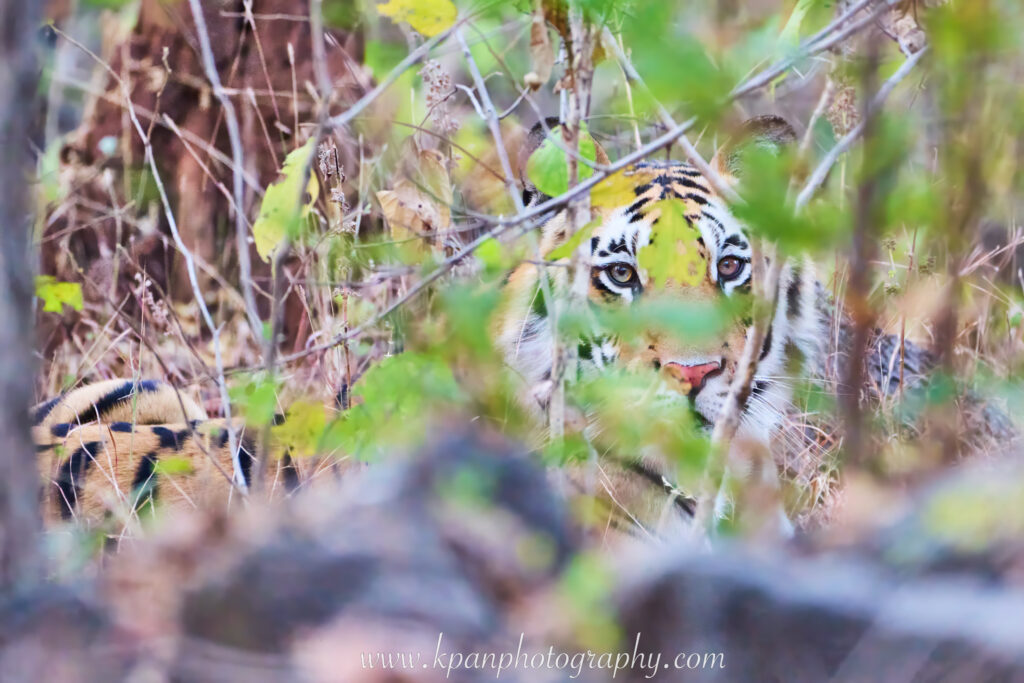
Personally I like the morning safari trip way better than the afternoon ones. In the morning, as soon as we enter the gate the hunting game begins and there is no beat around the bushes. We getting into looking for footprints or listening carefully to the warning calls right away and no fuss. As soon as there is something worthwhile to follow, then entire car’s people were on high alert and excited. It doesn’t matter if we could ultimately find a tiger, the process itself is exciting and full of drama. A few times as we were driving at cruising speed say 20 – 25 km/h and suddenly our local guide received a phone call from other guides and announcing a tiger was spotted. Immediately our driver would driving like there is no tomorrow at 40+ km/h speeding on winding, bumpy, unpaved muddy trails. There are typically three rows of seats and I usually sit at the last row where is the most bumpy and rough position in a car. After a few days traveling, my back starting to hurt. I figured out a way to keep myself a bit more comfortable and that is what I called a “horse riding” posture. I would hold on to the hand rail from the seat in front of me with one hand and then hold on to the hand rail from the back of my seat with another hand and half standing half squat without sitting on the seat to reduce the bumpy and roughness of the roads. It’s not a comfortable posture but for sure better than be throwing around like a sack of potato. As soon as the driver starting to drive like crazy, I would put myself into this horse riding posture right away. There was once we were late to exit the gate and must make the deadline, the driver hit the paddle to the metal. It’s not just me were throwing like a sack of potatoes so as my photo equipments. As I was making a few exclamation calls by seeing my photo equipment jumping in the mid-air, the driver even dare to looked back and asked “How is your camera?” I was so nervous and shouting back “Don’t you worry about my camera! Watch the road and drive! I want to LIVE!” The entire safari was ending in such a happy and exciting moment. What a memory!
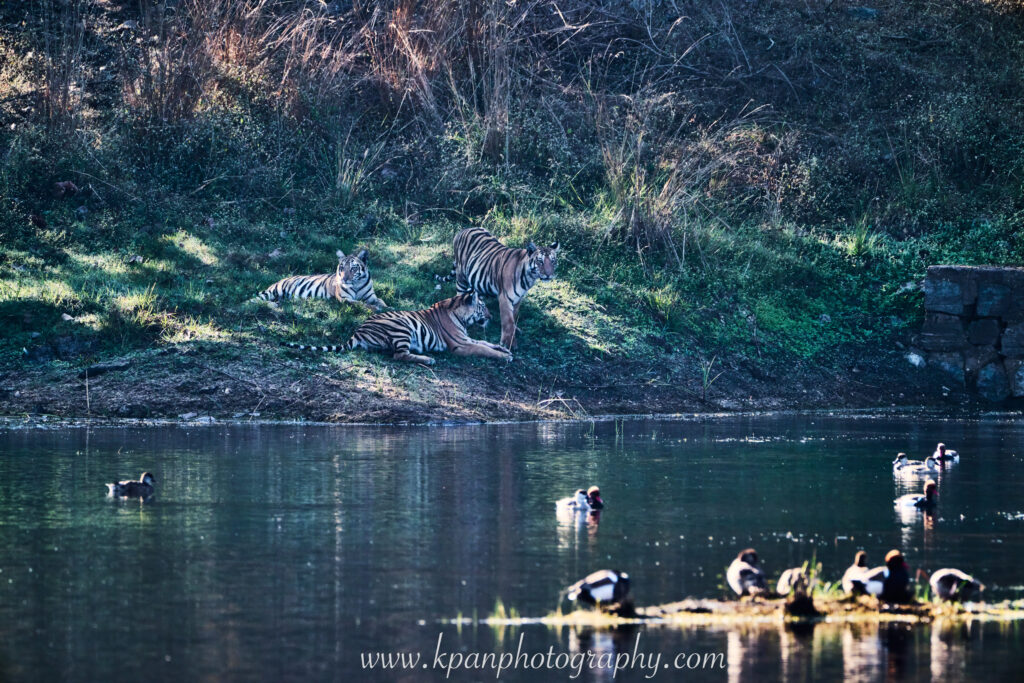
On the other hand, the afternoon safari was a bit boring most of the time. Usually the time to enter the gate is around 2:00pm or 2:30pm. It doesn’t matter what time to enter the gate tigers aren’t stupid. It’s the hottest time during a day and tigers would find a shady hide-out to take a long afternoon nap. What we have in our hands are a few serious issues: First, we don’t know where the tigers are and they usually hiding at a shady hide-out where is difficult to find. Then even if we found one, we don’t know when is the tiger going to wake up and must patiently wait. When the tiger finally wakes up, we worry what’s its next move. All these serious issues matters because it decides whether we could get good shot or not. So what we have are: 1. Where is it? 2. When is it going to wake up? 3. What’s it going to do after waking up? If we found one, we must be patiently waiting for it to wake up and we don’t know how long it is going to be. On the other hand, we usually were sitting in a roofless safari car and roasting by the sunlight during the entire time. Usually, we would find a tiger at around 3:00pm or so and it would wake up at around 4:30pm. But not every tiger would follow the playbook. There was once a tiger woke up at 4:15pm which is 15 minutes earlier than we expected and we were all in a rush trying to get our photo equipment ready to take shots. There were a couple of times the tiger over slept and didn’t wake up till 4:50pm or so. There was even once the tiger didn’t wake up and it’s 5:20 and we must leave because we must make the cut off time to exit the gate of the reserve. If we are late, according to the local guide, the local guide and driver would get verbal warnings. If they violated the rules too many times, they would get suspended and their licenses revoked. There was once I personally witnessed a few guides and drivers standing attention at the gate and listening to a boss-like person talking to them. According to our local guide, these were the people who made some mistakes and most likely exiting the gate late and they were being scolding by the boss. This is no joking matters and we must not linger when time comes. Tigers were just not that cooperative sometimes.
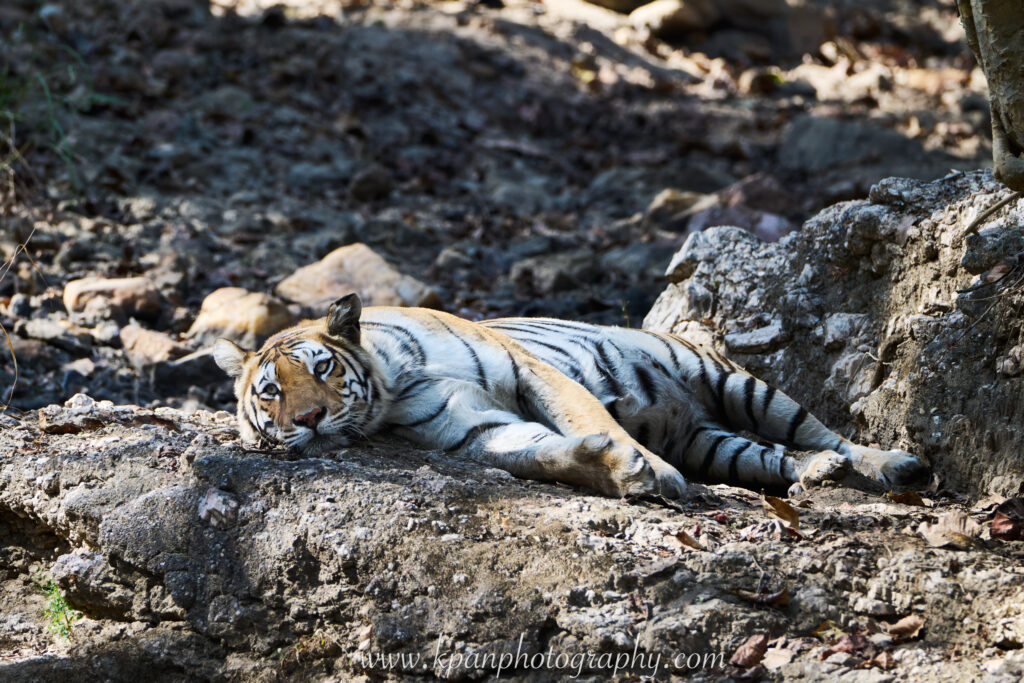
After all, I like the morning safari better than the afternoon ones because there is more actions, trackings and excitement. Unlike in the afternoon which is plenty of waiting and boring most of the time. Nonetheless, it doesn’t matter it’s morning or afternoon safari is an unusual experience. We don’t get this kind of experience when we are sitting in our sofa in our urban homes. If you are also interested in seeing, tracking wildlife, why not come to the wilderness and try it out yourself?
Three best shots
The word “photography” literally means “Using light to draw.” What would be the best way to make the light standing out? Darkness and/or shadows. In this image we see both lights and shadows. Moreover, it also demonstrates the characteristics of a tiger.
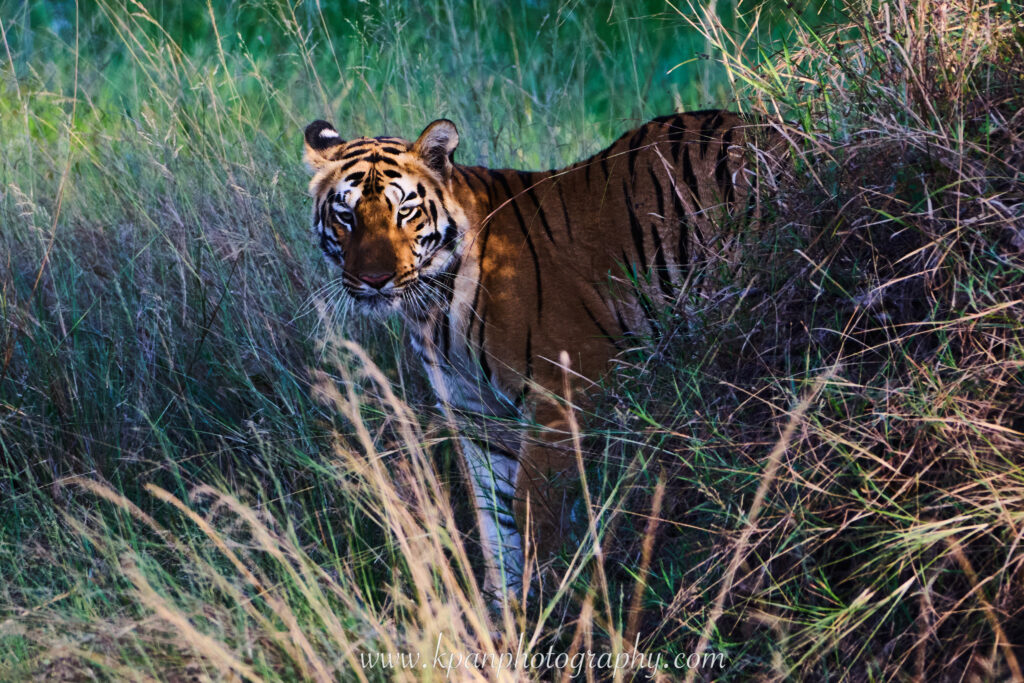
Whoever tried to track a tiger would know tiger is a kind of concealed and covert animal and its concealment and covert paint him mysterious and enigmatic. On the other hand, tiger also represents masculine, mighty and powerful. In this image the shadow side of its face serves tiger’s mysterious and enigmatic characteristic. The bright side represents tiger’s masculinity, might and power. Symbolism is a way for me to conduct my art expression and in my work. Moreover, contrast is my favorite approach to achieve it. This image carries both: symbolism vs. contrast, lights vs. shadows, mystery vs. might.
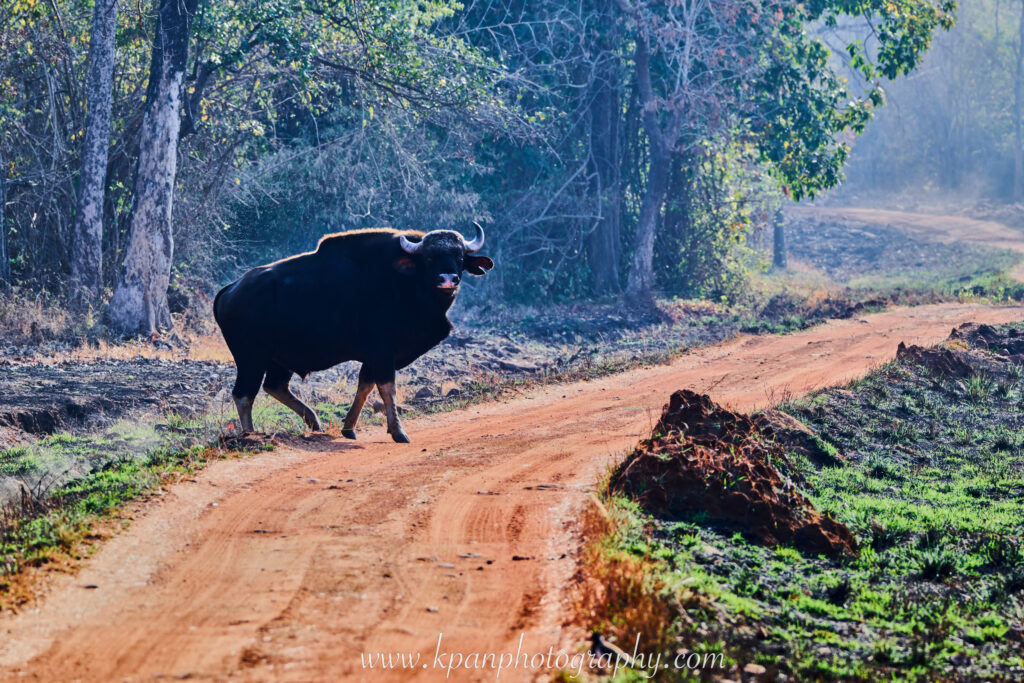
We could see the Indian Bull standing at the edge of the road and even sense its pause, hesitation, or confusion at the moment. Don’t we all have similar experiences when we were about to step onto a new path, plan, or decision? There are too many variables in our lives, too much uncertainties ahead of us, and too ambiguous of our future lay in front of us yet we must brave ourselves and marching on the long and narrow path. With the road in this image leads from near to far and the bull in the middle, we have foreground, middle ground and background. Moreover, the cold color, green, vs. the warm color, red brown, is yet another contrast. This image just, again, symbolizes a way of our lives.

Mother and baby images are always attracting people’s attention. However, what I want to emphasis in this image is the light in both the mother’s and baby’s eyes. Light symbolizes hope and future. In any moment in history, not just monkeys or animals, we as homo sapiens need hope to guide us moving forward and a bright future to aiming for. That’s the real reason I like this shot very much and pick it as one of the three best shots.
A beautiful picture is always welcome in my collection but I am greedy and hoping and aiming for more. I am expecting an image could reflect its creator’s thoughts, a way of representing his or her artistic creativity, and carrying something more than just a pretty picture. After all, isn’t that an artist’s job to inspire, intrigue, and provoke his or her audiences’ mind? Right?
Beaten up!
I have been facing many obstacles and difficulties ever since I adapted photography this irresistible hobbit but never one day I would imagine that I would be beaten up badly by my own photo equipment, seriously.
I participated a night safari at Peach National Park and that’s where and when it started. Needless to say, a night safari is to looking for tigers during the night in the darkness. The biggest challenge, of course, is lacking of light during the night. According to the national park’s rules, we can’t use any of our own artificial lighting. The head light of a safari car is the only light source we could rely on. This is not making things any easier. Other than stabilize a camera, using larger aperture is another way to gathering hopefully enough light to take a shot. In order to stabilize my camera and big lens, I decided to use a monopod and fix my camera and lens onto the monopod and this becomes the culprit which resulted in beating me up.
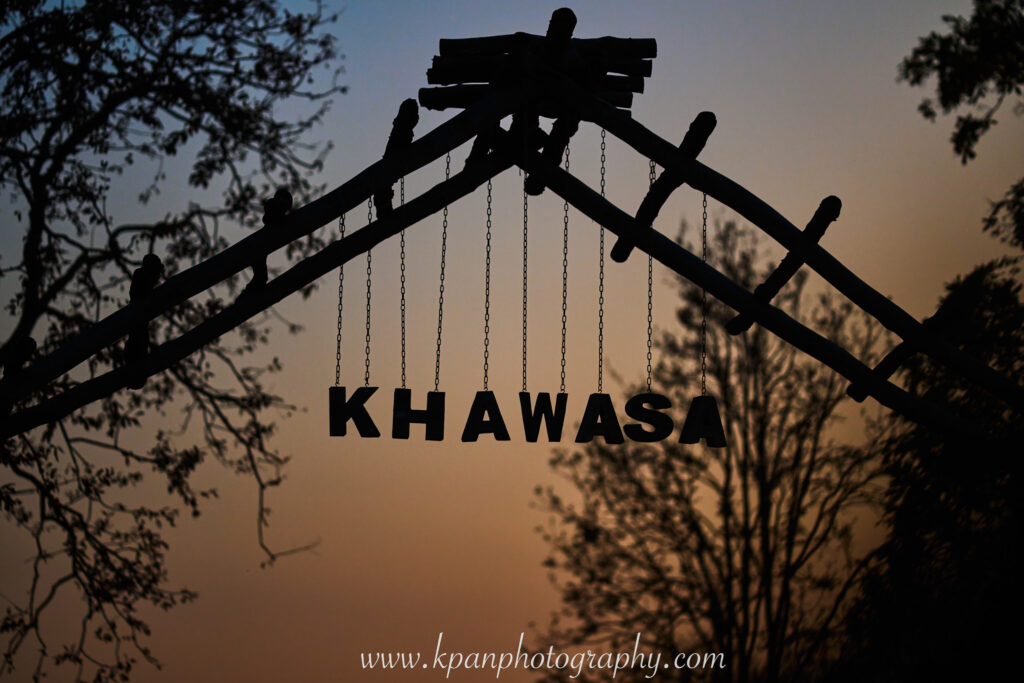
As soon as the safari car driving into the nightly road, I knew this is a big mistake. The road conditions are not ideal to say the lest even in the daytime not mention it’s during the night. It’s bumpy, winding and rough. My photo equipment would bouncing up and down on the seat so as the camera and lens in my hand along with the monopod. They bounced so badly I couldn’t hold on to them. The best I could do was to shorten the monopod, then holding onto it as hard as I could and trying my best to stabilize them. I easily underestimated the power of the bouncing car. It’s not just the photo equipment and the monopod, I myself was bouncing up and down half way in the air in my seat. Right at this moment, I felt a full hearty slap on my face. It’s my camera, of course. I tried to change my posture and position to hold the monopod. “Whimp!” This time was my head got smacked. I change my posture and position again, it’s my nose’s turn. I touched my nose to check on it and fortunately my nose wasn’t bleeding. Ultimately they are my equipment and take easy on my face but still hurts. The safari lasted for four hours, my equipment bounced for four hours and I was beaten up for four hours. The four whole hours!
Some of you may wonder why don’t I take the camera and lens off from the monopod first and re-attach them to the monopod when animals appear? I thought about it but, trust me, it won’t work. We were in the darkness in a forest, there was no light other than the headlights from the safari car. It’s dim, very dim to say the least. I will need to find the connection points between the monopod and the lens first after I see an animal. However, it’s next to impossible to find the connection points between the two in such dim light. Even if I made it, the animals were be gone by the time I made the connection happen. Animals won’t wait for anyone and I would lose an opportunity if I try to do it this way. I must have everything ready for the animal’s appearance and start shooting right away.
So, you may be wondering what image did I get from the night safari? The answer is none, zero, zip. The animals indeed appeared including rabbit, deer and something I saw only a glimpse of then disappeared. Why didn’t I get anything then? Because of the dim lighting, I couldn’t see very well. When I finally saw the animal, they were either too close or starting to run away. Even I had my equipment ready, it’s not fast enough to catch them. Hey, I paid the night safari ticket but the animals just don’t care!
After the entire four hours trip, my head hurts, my ear felt burning and my nose was swollen. After so many years photo taking journey, I have no face left. In addition to a beaten up face, I had nothing to show. Where could I file a complaint?
Three big NOs!
I visited two tiger reserves or national parks and both of them have these three big No No No rules: No smoking, No plastic bottles, and No mobiles.
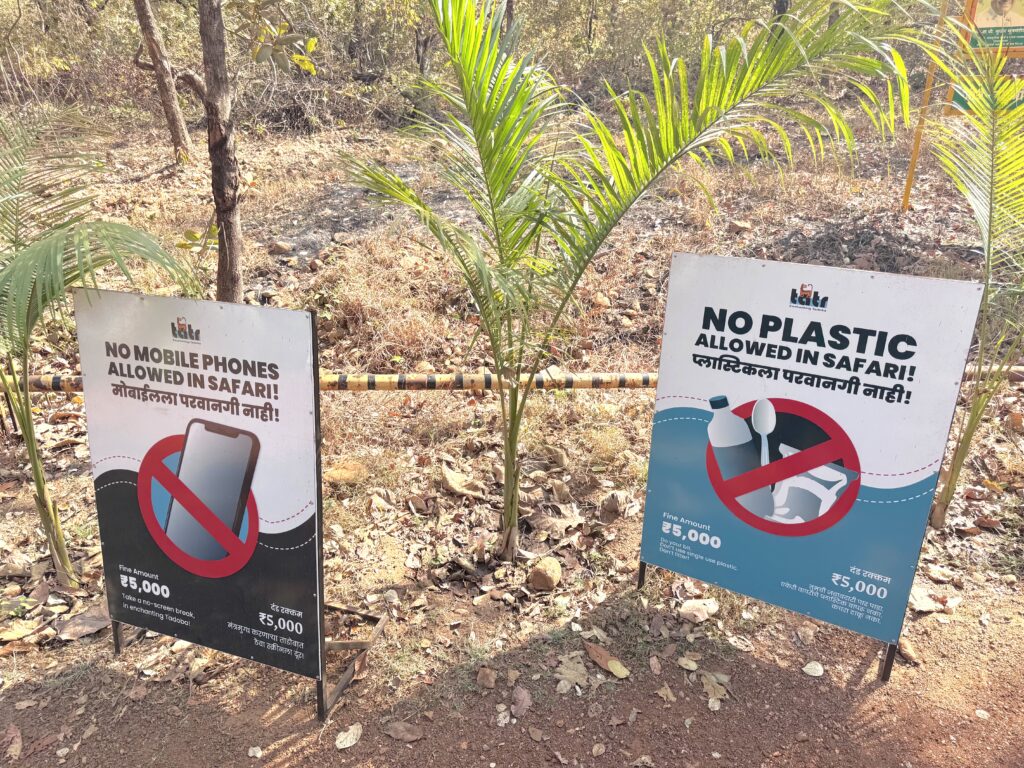
It’s easy to understand the first two. No smoking is because both places are dense forest and fire could destroy everything. No plastic bottles is also easy to understand and it’s preventing people throwing them around. It’s a tiger reserve and going to be very difficult to remove them. On the other hand, no mobile phones is a bit difficult to understand why and this is a big surprise to me. In reality, I really don’t care about mobile phones. I have too many photo equipment to deal with already and there really isn’t any extra hand to playing with my mobile phone. On the other hand, nowadays one could hardly see people going out without their mobile phones in their hands and this is against popular trends. I wonder why. There are actually multiple reasons. The first is because there are way too many tourists trying to take pictures with their mobile phones. Some of them were even trying to take a picture with a wild tiger. They would attempt to get off the car and take a shot with tiger in close distance. I was jokingly saying “Wow! Self-delivery food service. Eat fresh!” On the other hand, members in the same car with me were reminding me that we human beings may carry some deadly disease or virus to tigers and may poison them. This rule is strictly set up for tiger’s sack. Another reason is in case one of the tourist took a picture which is not appropriate to be posted on social media but ended up on social media which may not be a good thing for the park or reserve. The park or reserve may not even has a chance to make an explanation and it’s too late. Therefore, ban the mobile phones all together.
Personally I think it’s a good thing and even a great idea to ban the mobile phones in the park. It doesn’t matter where you go nowadays, you may see tons of people using their mobile phones take pictures. They often caused chaos by fighting positions, taking way too long on one spot and so on. Some internet celebrities even lost their lives just for a picture. If it happens something like this in any of the national parks or reserves, it’s no good for anybody. This is a good rule and excellent idea. What even more surprising me was I didn’t see anyone arguing or violating it. I don’t see anyone taking out a mobile phone during my trips and everyone following the rule. I must give these parks a big thumbs up!
Five tigers at the bank of a lake
We entered the park at 6:00am and by 6:30 we ran into a mother tiger with her 4 cubs hunting, feeding, drinking water and strolling along a lake bank. This is a very hard to come by opportunity because usually a female tiger bear only two cubs and this one has 4. This is a four year old tigress named B2 and her 4 cubs are less than one year old. If we just see the cubs, we wouldn’t think they are cubs because they looked pretty big and strong. It was not till the mother tiger walk along with one of the cubs, we could obviously tell the size difference.

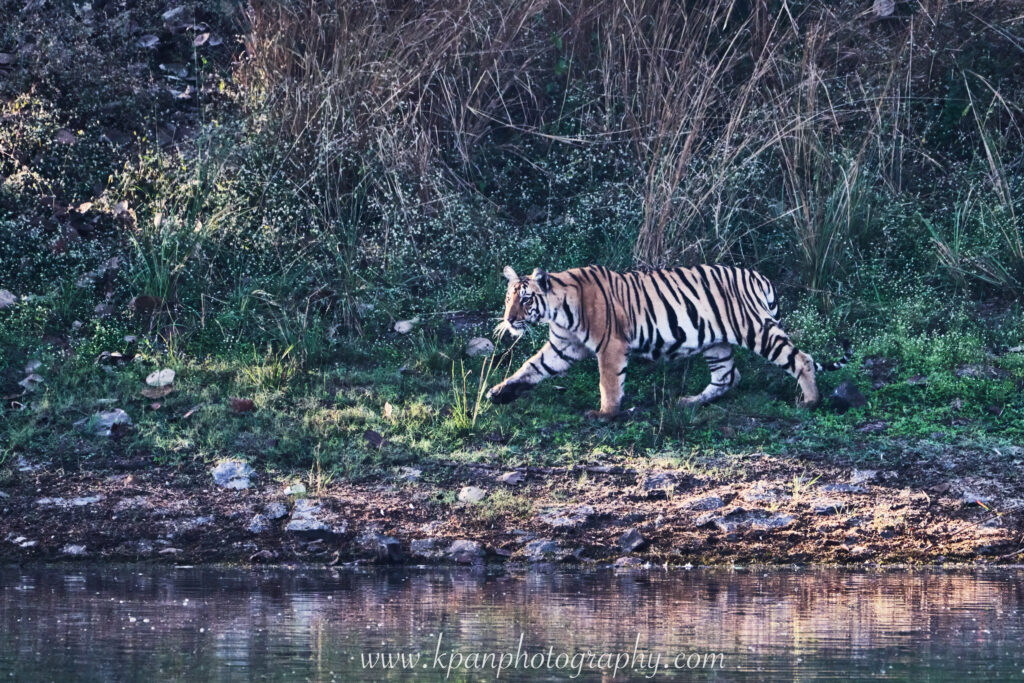
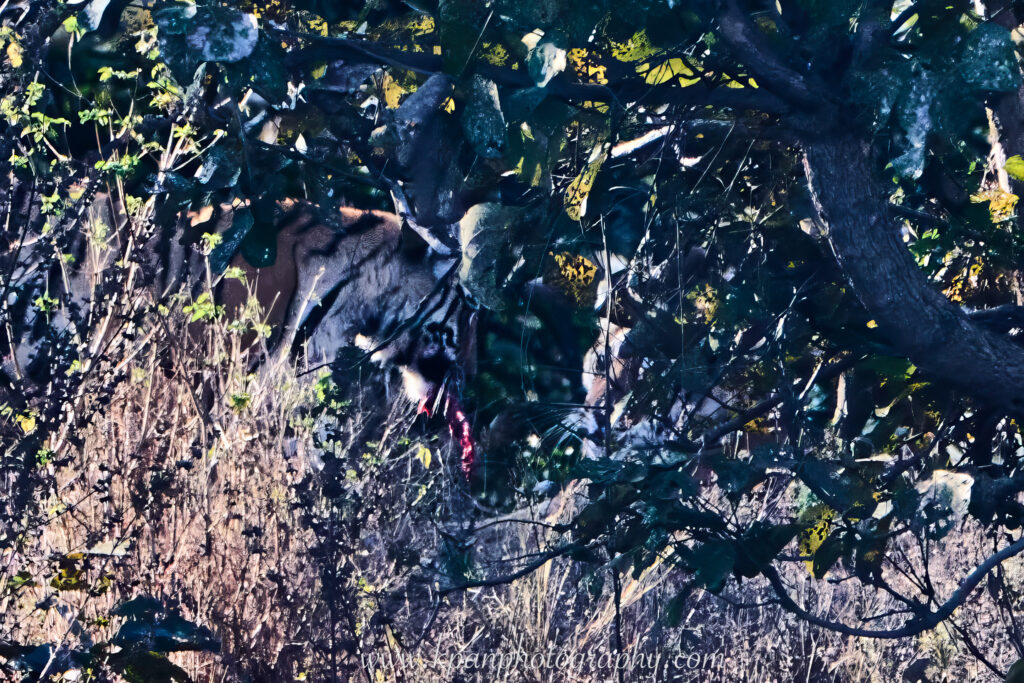
There was a lake between our position and the tigers. I estimated the distance between us was about 3 to 4 hundred meters (1,000 to 1,300 feet) but people share the same car with me estimated 5 to 6 hundred meters (1,600 to 2,000 feet). It’s far away after all. In addition to the distance, the light wasn’t ideal either because of the very early morning and the tigers were on the shady side. The results weren’t excellent but the point is to observe all five tigers together at one spot and track their movements. We could see that they just finished a morning hunting and enjoying their breakfast. We don’t know what was the prey because the distance was just way too far. Nevertheless, its prey mustn’t be small judging by the size of the bone in their mouth.
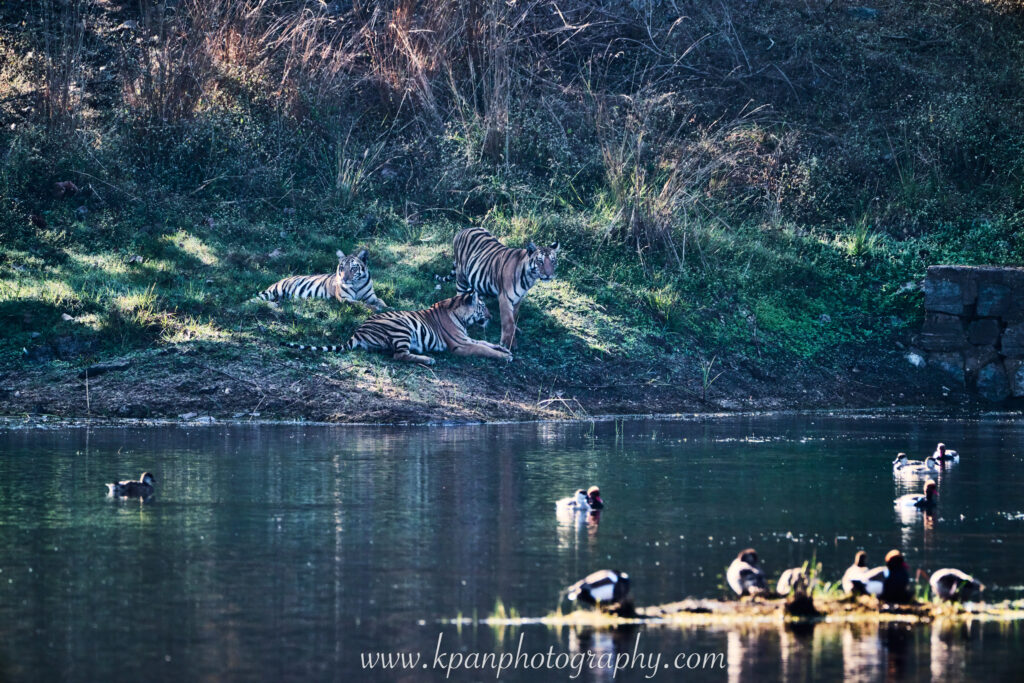
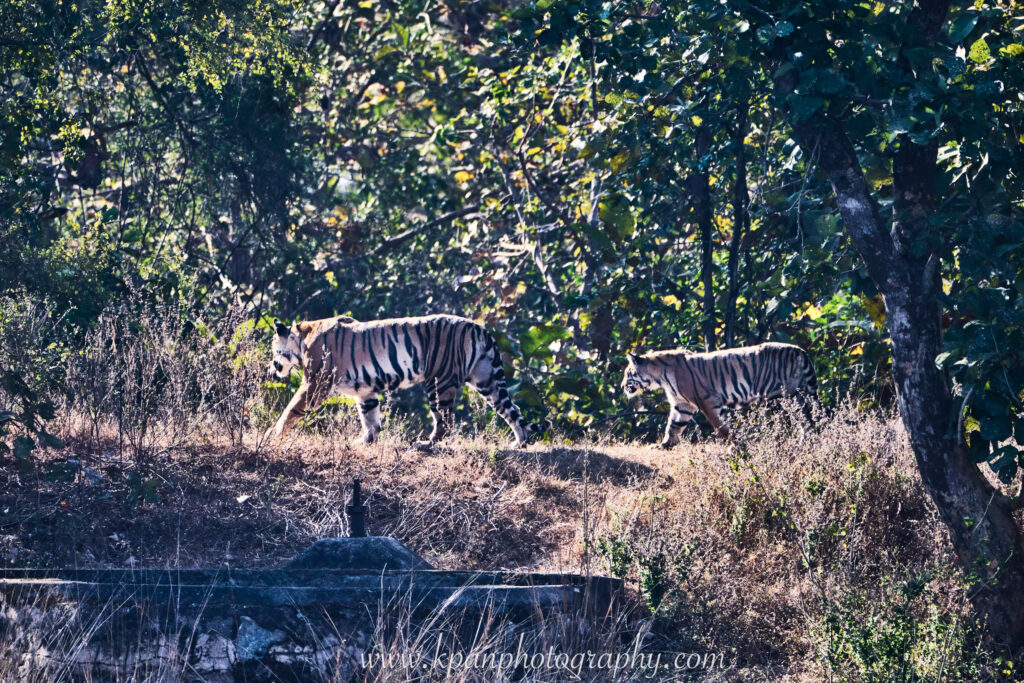
Let’s play a seeking game and see how many tigers you could find in the following picture. Answer will be provided at the end of this section.
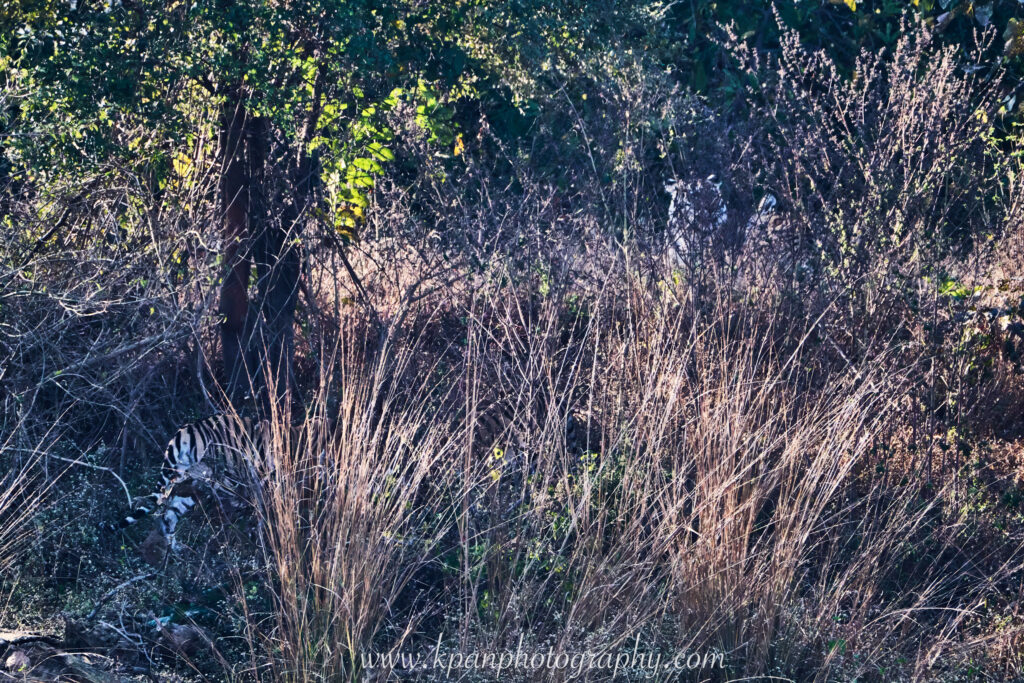
Answer:
There were 4 tigers in this picture. You may see 3 ears at the upper right side so there were 2 tigers there. There was one at the lower left side and another one just to its right. So, totally there were 4 tigers. After seeing this picture, would you have a better understanding of how hard in hunting and searching a tiger?
Leopard
Honestly speaking, I had never expected to see a leopard before I started this trip because nothing mentioned about leopard at all. All I have heard was this is a tiger hunting safari. It’s not till before we start the safari trip that afternoon, our guide Jess Reporter mentioned that there was a chance to see leopard in this area. I heard what she said but never pay any attention to it. In my mind, leopard is harder to track and see than tigers and if we were having hard time to see a tiger, it’s even harder to see a leopard. I wasn’t paying any attention nor holding my breath.
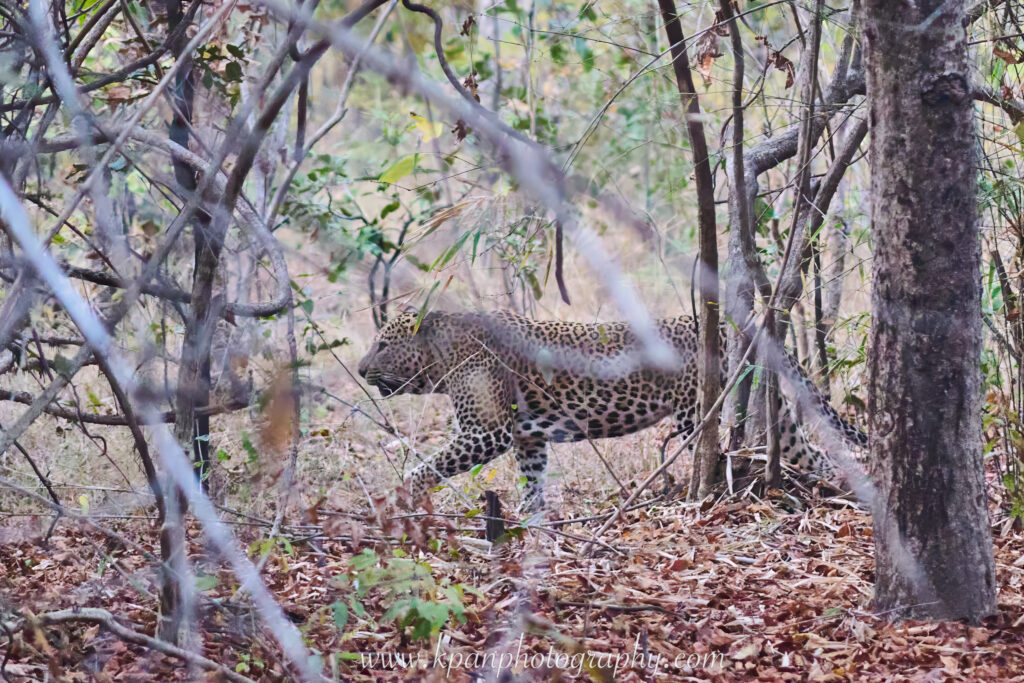
It’s 6:00pm and almost at the very end of the safari because we must exit the park at 6:30, suddenly our local guide received a phone call and announced a leopard showed up. Immediately after the safari car was accelerated like a bullet. I was sitting at the very back, third row of the seat, and must hold on very tight to the safety rail to the seat in front of me. Otherwise, I might get thrown out from the car. After a period of high speed riding, leopard! We saw a leopard! It’s very dark at the time already and I must use that 120-300mm f2.8, a lens from the DSLR era, to take advantage of its f2.8 fast aperture. Even with a fast aperture at f2.8, I could barely get clear images. It’s just too dark.
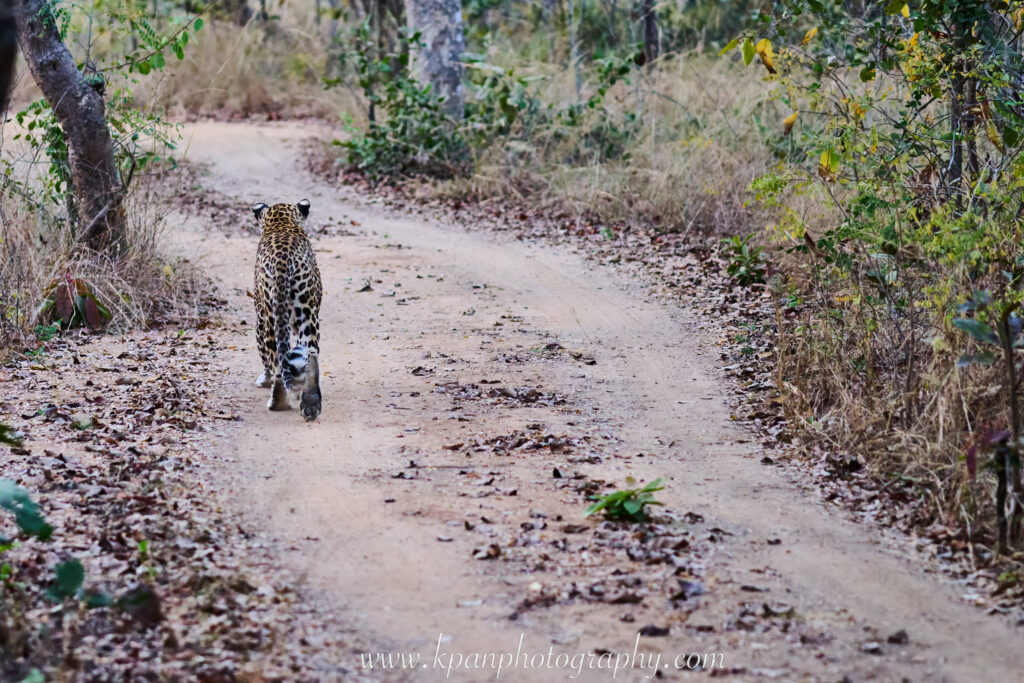
However, our problem was way bigger than not enough light. Because of the angle we ran into the leopard, we could hardly see the face of the leopard at all and couldn’t get a clear frontal face shot. There was only one moment, the leopard looking at our direction while walking along the path and a very brief moment. There was no second chance whatsoever. Needless to say, everyone was excited by the opportunity of seeing a leopard in the park including our local guide and driver. When I got the last shot with the leopard disappeared into the bushes, it’s 6:24 already. In another words, our local guide and driver were taking the risk of being penalized by the park administration to accompany us to the end. I really appreciate they worked so hard for us tourists. Kudo to them!
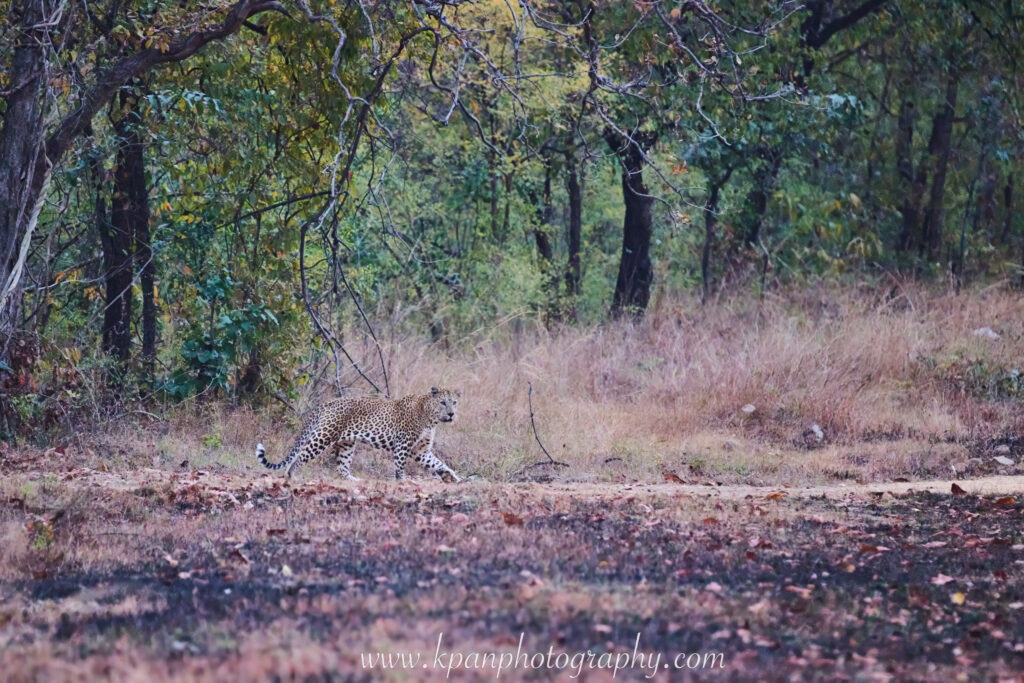
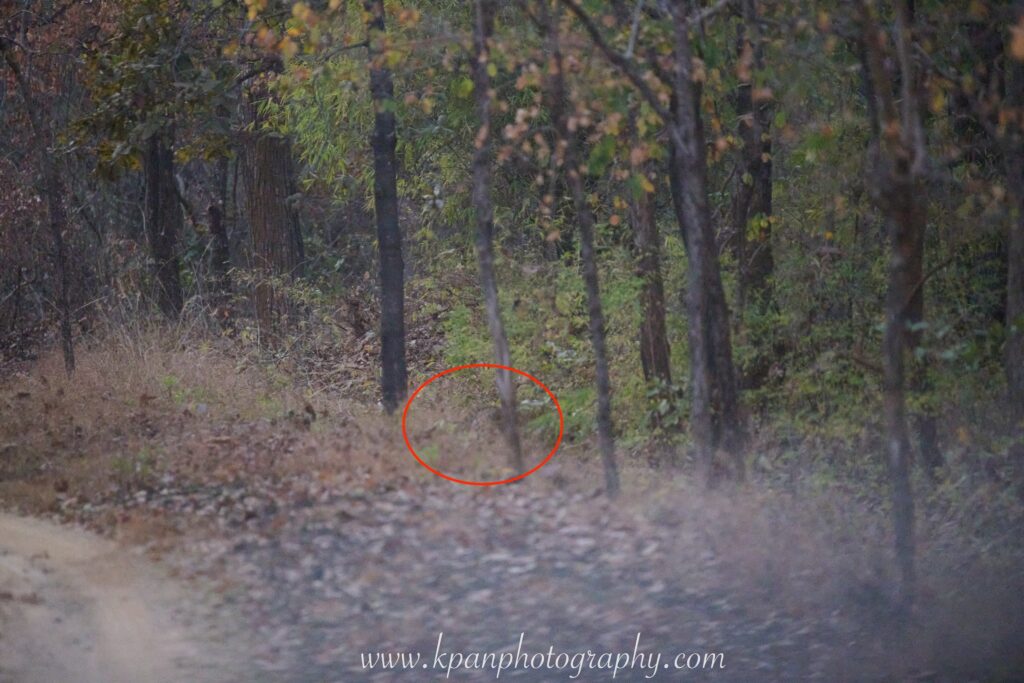
Blue-eyed tigress
This is a three years old tigress named Nayantarra. Her special feature is she has a pair of blue eyes. When we caught her she was in her afternoon nap. Our guide Jess Reporter introduced her to us specially emphasized her beautiful blue eyes. I heard what she said but I have never known there is a blue eyes tiger exist. I am stubborned and must see it myself to believe it.
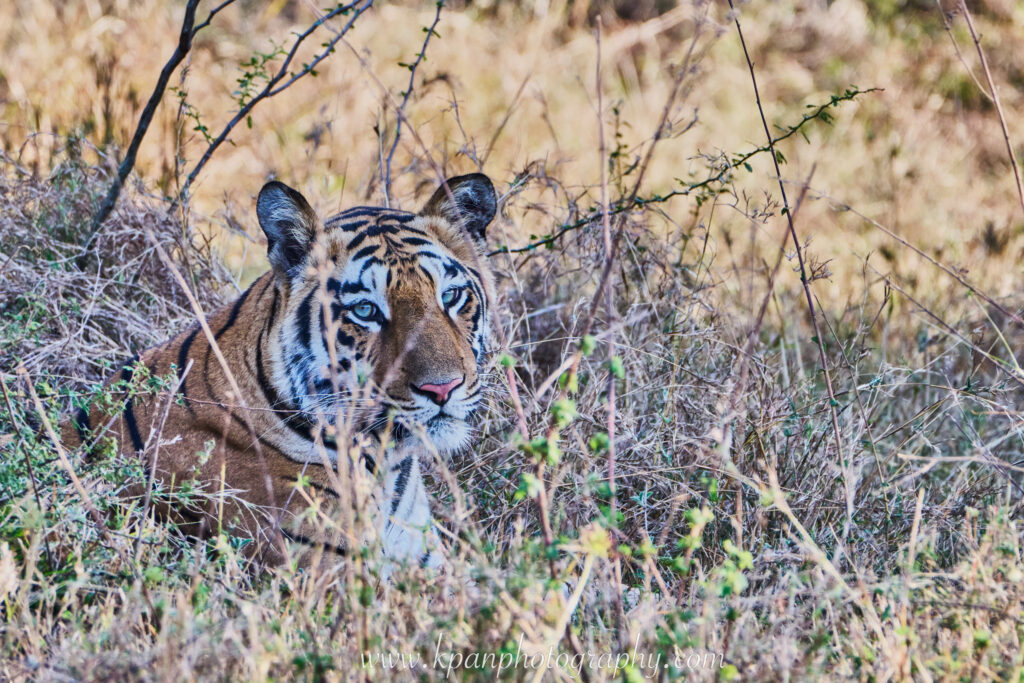
We waited for her from 3:00pm and she didn’t wake up till 4:30pm. We then waited another 10 minutes for her to get up and started to move around then we finally had a chance to catch her images. While I was extremely focused on catching her images through the camera viewfinder, I just didn’t see the blue eyes. I don’t understand why even up to now. I really didn’t see blues in her while I was taking pictures of her. When I was staring at Nayantarra through the viewfinder, I heard Jess talking about her blue eyes again. I didn’t had a chance to talk because I was too focus in looking into the viewfinder to do anything. However, in my mind I was thinking “Jess, are you too tired? Have you gone mad? I am here looking at her right now and just don’t see blue eyes at all!” Even in our dinner time that night, Jess was talking about Nayantarra’s blue eyes. I smiled back politely and didn’t say anything.

It’s not till two weeks later I started to do the post process at home, suddenly the two blues eyes jumping right in front of me on the computer screen. I was surprised and awing for its beauty. The blue was so deep, vibrant, charming and intoxicating. There is no way that I don’t believe it anymore. I even immediately texted Jess and told her how beautiful the pair of blue eyes are and sincerely apologize for doubting her at the time. Solute to Jess again for her professionalism.
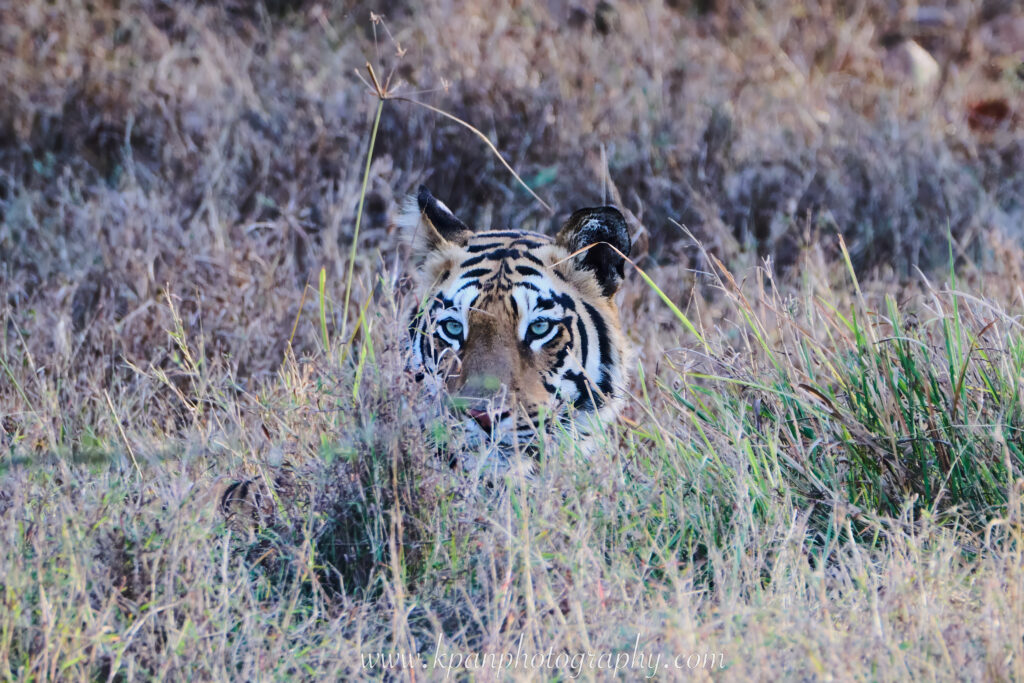
“Personating” or “Imitating of Animals”
I specifically picked these two images and posted them here because they gave me a feeling of resonance. Look at the tiger stretching out her neck, closing her eyes and let the last sunshine before sunset shining on her face. She looked so satisfied. Don’t we human beings behave similarly from time to time?
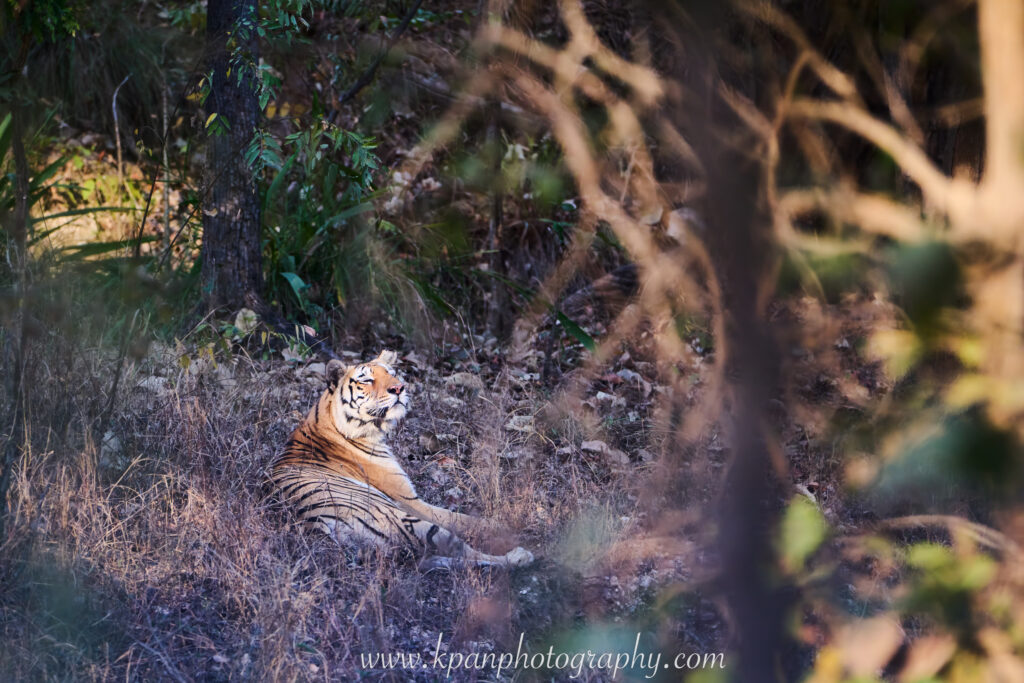
Then look at the expression of the monkey on his face. It’s like he is feeling and enjoying the breeze caressing its face and body, the breathing from earth, the pulse of the nature. We always used the word “personate” to describe certain behaviors from animals. However, don’t forget these animals are way older than us homo sapiens in the long history of evolution. Maybe, we should have a word for “imitating of animals” for us human beings.
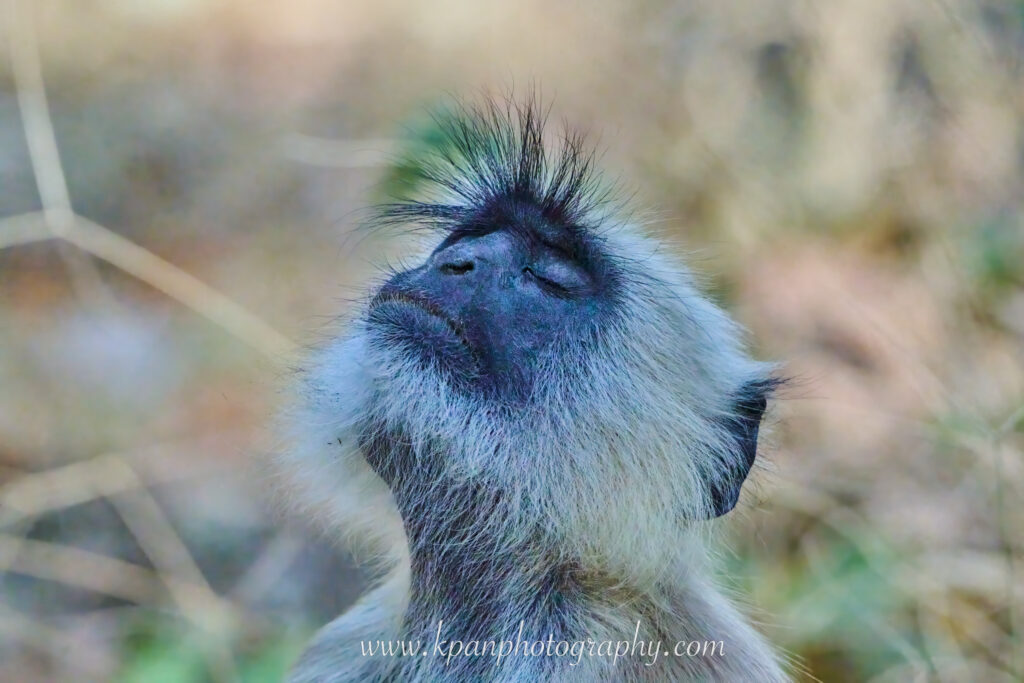
Phantom dancer

In the process of tracking and hunting tigers, we would run into other animals from time to time. This great egret is an excellent example. When we passed by a lake, there was this beautiful great egret looking for breakfast.
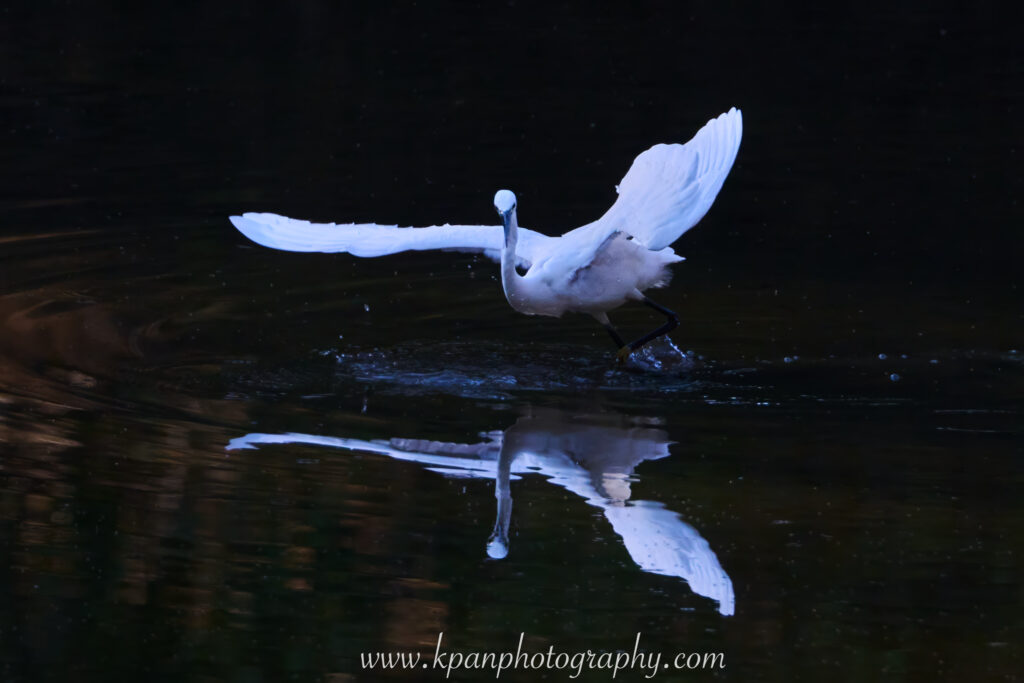
It’s early in the morning and only about 8:30 or so. The sun ray hadn’t penetrated this part of the forest. Because of lacking the sun light the darkness make the almost pure white great egret standing out like a phantom dancing in the middle of the air with its reflections. It’s absolutely gorgeous and mesmerizing.

Because of the close to pure white great egret, the camera would definitely over-expose with standard exposure in such dark background, therefore, I dialed down the exposure parameter by one and two-third stops in advance to get near correct exposure. Of course, by doing so would further darken the background but that’s exactly what I intended to do to make the white great egret standing out even more. I used 1/2000th second fast shutter release to freeze the Great Egret’s action. Needless to say by doing so I pushed the ISO up to 4,000 but this was a well calculated compromise. Fortunately, the modern sensor in digital cameras performs superb and reduces the sensor noise to the very minimum. I also used software to further reduce the sensor noise to make the image even more clean.
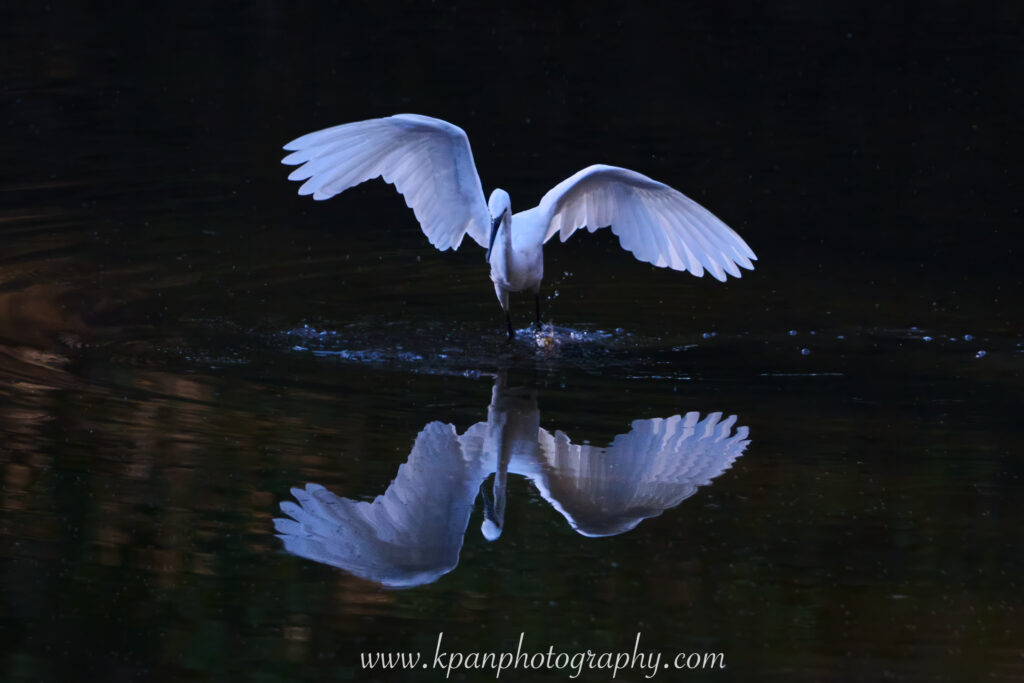
The result is gorgeous, dreamy and a thin sense of phantom floating in the mid-air with its own shadow. It’s surreal.
Strong color and mood contrast
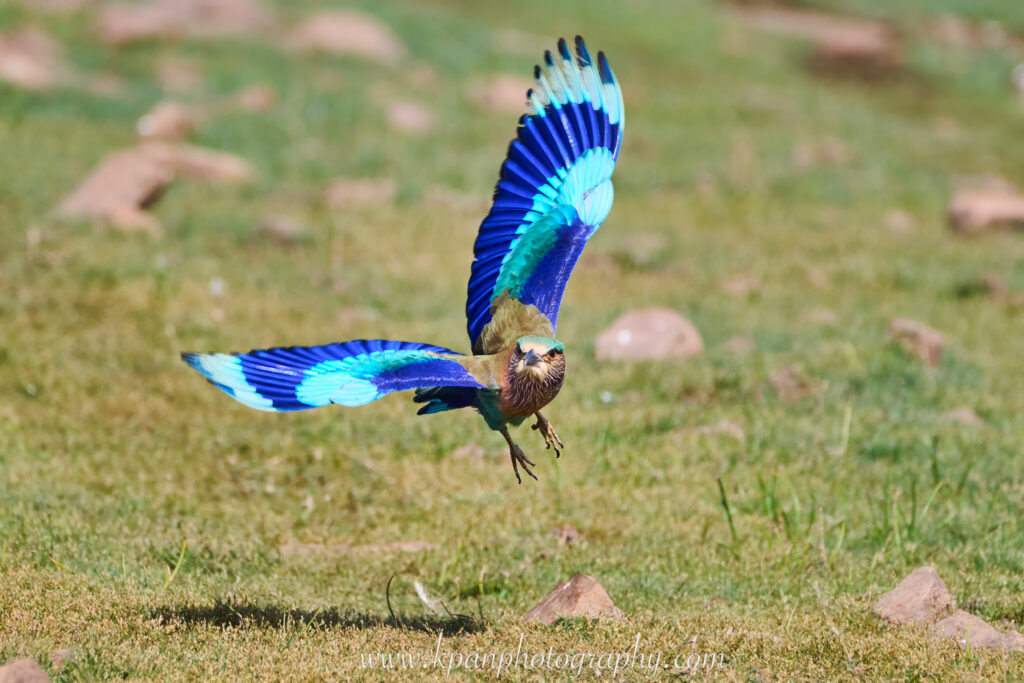
These few images of lilac-breasted Roller are totally different than the images of great egret in the previous section. It’s almost a total opposite feeling and mood, a huge contrast.
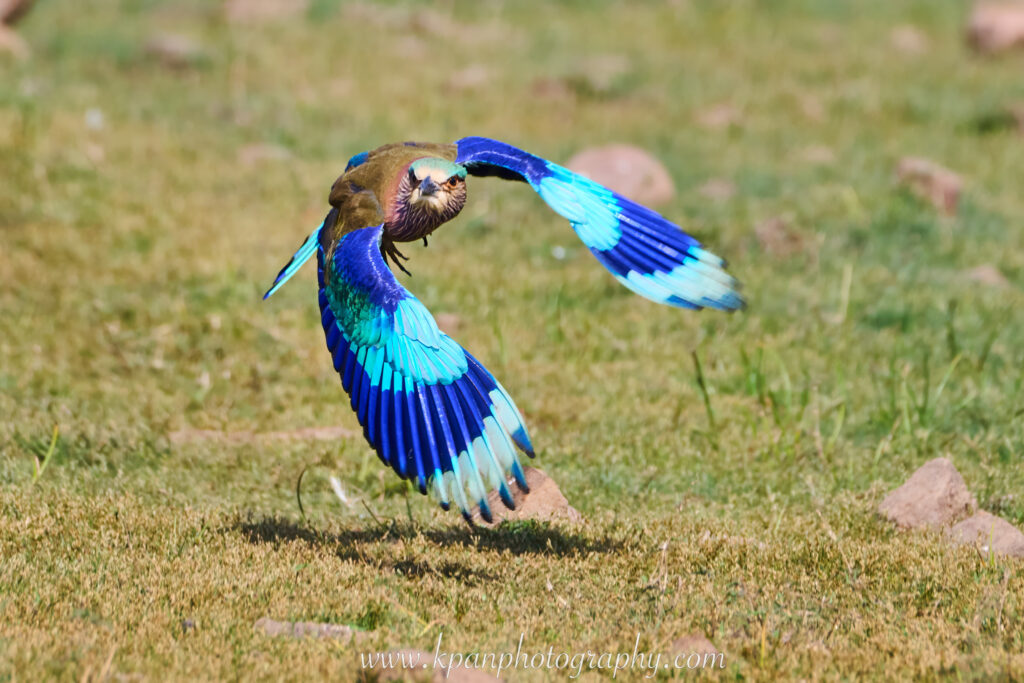
This roller dances under the sunshine giving us the feeling of sunny, vitality and vibrant.
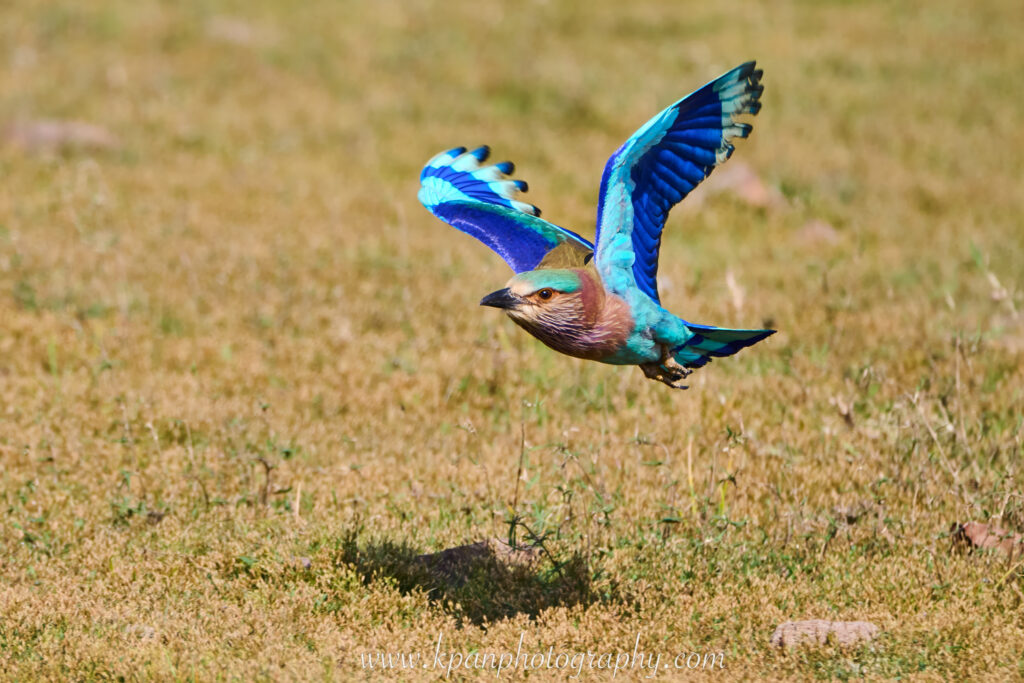
It’s like breeze in spring and flashing stars under summer nights. An entirely different experience and feel. This is partially what I am looking for in outdoor photography: differences, contrasts and experiences.
